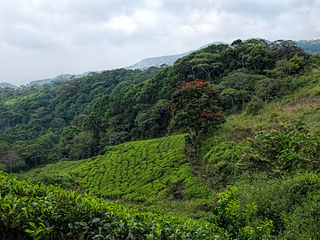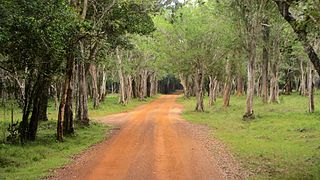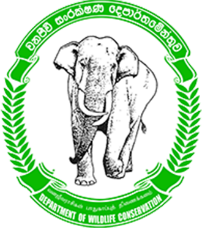Related Research Articles

Yala (යාල) National Park is the most visited and second largest national park in Sri Lanka, bordering the Indian Ocean. The park consists of five blocks, with three of which are now open to the public. There are also two adjoining parks, Kumana National Park or 'Yala East' and Lunugamvehera National Park. The blocks have individual names, such as Palatupana. It is situated in the southeastern region of the country, in the Southern Province and Uva Province. The park covers 979 square kilometres (378 sq mi) and is located about 300 kilometres (190 mi) from Colombo. Yala was designated as a wildlife sanctuary in 1900, along with Wilpattu, designated in 1938, as the first two designated national parks in Sri Lanka. The park is best known for its variety of wildlife and is important conservation of Sri Lankan elephants, Sri Lankan leopards and aquatic birds.

Sinharaja Forest Reserve is a forest reserve and a biodiversity hotspot in Sri Lanka. It is of international significance and has been designated a Biosphere Reserve and World Heritage Site by UNESCO.

Tourism in Sri Lanka is growing rapidly. For centuries, Sri Lanka has been a popular place of attraction for foreign travelers. The Chinese traveler Fa-Hien visited Sri Lanka as early as the 410's AD/CE, and in the twelfth century, Italian explorer Marco Polo claimed Sri Lanka to be the "best island of its size in the world".

The Sri Lankan elephant is native to Sri Lanka and one of three recognised subspecies of the Asian elephant. It is the type subspecies of the Asian elephant and was first described by Carl Linnaeus under the binomial Elephas maximus in 1758. The Sri Lankan elephant population is now largely restricted to the dry zone in the north, east and southeast of Sri Lanka. Elephants are present in Udawalawe National Park, Yala National Park, Lunugamvehera National Park, Wilpattu National Park and Minneriya National Park but also live outside protected areas. It is estimated that Sri Lanka has the highest density of elephants in Asia. Human-elephant conflict is increasing due to conversion of elephant habitat to settlements and permanent cultivation.

The Sri Lanka dry-zone dry evergreen forests are a tropical dry broadleaf forest ecoregion of the island of Sri Lanka.

The Sri Lankan leopard is a leopard subspecies native to Sri Lanka. It was first described in 1956 by Sri Lankan zoologist Paules Edward Pieris Deraniyagala.

Wilpattu National Park is a national park in Sri Lanka. The unique feature of this park is the existence of "Willus" – natural, sand-rimmed water basins or depressions that fill with rainwater. Located on the northwest coast lowland dry zone of Sri Lanka, the park is 30 km (19 mi) west of Anuradhapura and 26 km (16 mi) north of Puttalam. The park is 1,317 km2 (508 sq mi) in area and ranges from 0–152 m (0–499 ft) above sea level. Nearly one hundred and six lakes (Willu) and tanks are found spread throughout Wilpattu. Wilpattu is the largest and one of the oldest national parks in Sri Lanka. Wilpattu is world-renowned for its leopard population. A remote camera survey conducted in Wilpattu from July to October 2015 by the Wilderness and Wildlife Conservation Trust captured photographs of forty-nine individual leopards in the surveyed area, the core area density of which was between that of Yala National Park's Block I and Horton Plains National Park.

Deforestation is one of the most serious environmental issues in Sri Lanka. Sri Lanka's current forest cover as of 2017 was 29.7%. In the 1920s, the island had a 49 percent forest cover but by 2005 this had fallen by approximately 26 percent. Between 1990 and 2000, Sri Lanka lost an average of 26,800 ha of forests per year. This amounts to an average annual deforestation rate of 1.14%. Between 2000 and 2005 the rate accelerated to 1.43% per annum. However, with a long history of policy and laws towards environmental protection, deforestation rates of primary cover have decreased 35% since the end of the 1990s thanks to a strong history of conservation measures. The problem of deforestation in Sri Lanka is not as significant in the southern mountainous regions as it is in northern and lowland southern Sri Lanka, largely due to the nature of environmental protection.

The Department of Wildlife Conservation is a non-ministerial government department in Sri Lanka. It is the government department responsible for maintaining national parks, nature reserves and wildlife in wilderness areas in Sri Lanka. Forest reserves and wilderness areas are maintained by the Department of Forest Conservation. The head of the department is the Director General of Wildlife Conservation, formally known as Warden. It was established in October 1949 with Captain Cyril Nicholas, MC as its first Warden.

Rishad Bathiudeen is a Sri Lankan parliamentarian and former senior cabinet minister. He is the leader of the All Ceylon Makkal Congress (ACMC) Party, a registered political party in Sri Lanka. Bathiudeen was elected as a Member of Parliament (MP) from the Vanni Electoral District in December 2001 and was re-elected in April 2004, after which he was again re-elected in April 2010 and 2015 June from the same Electoral District which comprises Vavuniya, Mannar and Mullathivu Administrative Districts. Rishad Bathiudeen holds a National Diploma in Technology (NDT) in Civil Engineering from the University of Moratuwa, Sri Lanka and is also a member of the Chartered Institute of Engineering (C.I.E.) in the UK.

Mattala Rajapaksa International Airport (MRIA) (Sinhala: මත්තල රාජපක්ෂ ජාත්යන්තර ගුවන්තොටුපළ, romanized: Mattala Rājapakṣa Jātyantara Guvantoṭupaḷa; Tamil: மத்தல ராஜபக்ஷ சர்வதேச விமானநிலையம், romanized: Mattala Rājapakṣa Carvatēca Vimāṉanilaiyam) (IATA: HRI, ICAO: VCRI) is an international airport serving southeast Sri Lanka. It is located in the town of Mattala, 18 km (11 mi) from Hambantota. It is the first greenfield airport and the third international airport in the country, after Ratmalana International Airport and Bandaranaike International Airport in Colombo.
Kokkilai Sanctuary is a wildlife sanctuary in north eastern Sri Lanka, approximately 25 km (16 mi) south east of Mullaitivu.

The Samagi Jana Balawegaya is a political alliance that is led by the opposition leader of Sri Lanka, Sajith Premadasa. The alliance was formed with the approval from the working committee of the United National Party (UNP) to contest the 2020 Sri Lankan parliamentary election. On 11 February 2020, the election commission of Sri Lanka announced that they have accepted the party as a recognised political party in Sri Lanka. Ranjith Mandumabandara was named as the General Secretary of the party. Jathika Hela Urumaya (JHU), Sri Lanka Muslim Congress (SLMC) and the Tamil Progressive Alliance (TPA) joined the new alliance on 12 February 2020.

The Pearl Protectors is a youth-led marine conservation organisation. Established in 2018, The Pearl Protectors seek to reduce plastic pollution and conserve the marine environment through youth engagement, volunteerism, awareness and advocacy.

Jagath Gunawardana is a lawyer, environmentalist and educator based in Sri Lanka. Gunawardana is known for his advocacy in wildlife conservation and environmental protection.

Environmental Foundation Limited (EFL) is a public interest litigation and environmental conservation organisation in Sri Lanka. Established in 1981, EFL seeks to protect and conserve the natural environment through litigation, advocacy, awareness and youth-engagement.

Anjali Watson is a Sri Lankan conservationist. She is known for her contributions to leopard conservation and founded the Wilderness and Wildlife Conservation Trust, a conservation and research organisation.

Centre for Environmental Justice is an environmental conservation and public interest litigation organisation in Sri Lanka. The organisation is a member of the Friends of the Earth International network which is the world's largest international grassroots environmental network.
Human-elephant conflict (HEC) is a large threat to both species in certain rural areas of Sri Lanka. About 250 elephants and 80 people die each year, and property is also destroyed. Most elephant calves are killed by the hunting method known as "Hakka Pattas" In 2020, the Department of Wildlife Conservation estimated that there were 7,000 elephants in the country. The department's official records show that more than 361 elephants were killed in 2019. Sri Lanka has the highest number of elephant kills of any country in the world.
References
- ↑ "Wildlife & Nature Protection Society of SriLanka turns 125 - Life Online". www.life.lk. Retrieved 2021-01-12.
- ↑ "INSURANCE SCHEME COVERING 2500 EMPLOYEES OF DWC". epaper.dailymirror.lk. Retrieved 2021-01-13.
- ↑ "WNPS Monthly Lecture on Lankan blue whales within a global context | Daily FT". www.ft.lk. Retrieved 2021-01-12.
- ↑ "Beach nourishment: Was an Environmental Impact Assessment done or not? | Daily FT". www.ft.lk. Retrieved 2021-01-13.
- ↑ "WNPS expresses serious concern over wild boar meat trade | Daily FT". www.ft.lk. Retrieved 2021-01-13.
- ↑ "Mounting jeep safaris make Yala animals snarl". www.dailymirror.lk. Retrieved 2021-01-13.
- ↑ Imtiaz, Zahrah. "Yala under threat". Daily News. Retrieved 2021-01-13.
- ↑ "Trunk call to railways". Sunday Observer. 2018-10-20. Retrieved 2021-01-13.
- ↑ "Relocating Sinharaja elephants: May sense prevail! | Daily FT". www.ft.lk. Retrieved 2021-01-13.
- ↑ Ables, Kelsey. "Caught between culture and controversy". Daily News. Retrieved 2021-01-13.
- ↑ "Schooling of conservation awareness: WNPS Youth Wing inspires next generation of conservation heroes | Daily FT". www.ft.lk. Retrieved 2021-01-13.
- ↑ "'If we go on like this, we're going to have nothing left in the next 25 years'". Nation Online. Retrieved 2021-01-12.
- ↑ "It's time to rethink how humans and elephants could coexist". www.dailymirror.lk. Retrieved 2021-01-12.
- ↑ "Saving a Species: The Future Of The Human Elephant Conflict". roar.media. Retrieved 2021-01-12.
- ↑ Sooriyagoda, Lakmal. "CoA issues notices on Environment Minister, 23 others". Daily News. Retrieved 2021-01-12.
- ↑ MENAFN. "Protection of wildlife equals protection of humans". menafn.com. Retrieved 2021-01-12.
- ↑ "'Black panther' not different species but melanistic colour variant – Wildlife Dept". EconomyNext. 2020-01-21. Retrieved 2021-01-13.
- ↑ "For Sri Lanka's dwindling leopards, wire snares are the leading killer". Mongabay Environmental News. 2020-06-05. Retrieved 2021-01-12.
- ↑ "A look at marine conservation in 2020 and how we can move forward". Nation Online. Retrieved 2021-01-12.
- ↑ "Endangered thresher sharks targeted by sports fishing company in breach of the law | Daily FT". www.ft.lk. Retrieved 2021-01-13.
- ↑ "Wilpattu National Park severely affected by unregulated activities of Pallekandal Church | Daily FT". www.ft.lk. Retrieved 2021-01-13.
- ↑ "Damage caused to Wilpattu National Park by activities of Pallekhandal Church | Daily FT". www.ft.lk. Retrieved 2021-01-13.
- ↑ "Environmentalists win 'landmark' case against biofuel project in Sri Lanka". Mongabay Environmental News. 2015-10-15. Retrieved 2021-01-13.